A3007
N-Acetylmuramic acid
≥98% (TLC)
Synonym(s):
(R)-2-(Acetylamino)-3-O-(1-carboxyethyl)-2-deoxy-D-glucose, 2-Acetamido-2-deoxy-3-O-(D-1-carboxyethyl)-D-glucopyranose, MurNAc, NAMA
About This Item
Recommended Products
biological source
synthetic
Quality Level
Assay
≥98% (TLC)
form
powder
technique(s)
thin layer chromatography (TLC): suitable
impurities
≤1 mol/mol methanol
color
white
mp
125 °C ((257 °F ))
solubility
water: 50 mg/mL, clear, colorless
storage temp.
2-8°C
SMILES string
CC(O[C@H]1[C@H](O)[C@@H](CO)OC(O)[C@@H]1NC(C)=O)C(O)=O
InChI
1S/C11H19NO8/c1-5(11(18)19)20-10(9(17)8(16)4-14)7(3-13)12-6(2)15/h3,5,7-10,14,16-17H,4H2,1-2H3,(H,12,15)(H,18,19)/t5-,7+,8-,9-,10-/m1/s1
InChI key
SOARVSUSWULNDI-TVVSKHENSA-N
Looking for similar products? Visit Product Comparison Guide
Application
Packaging
Other Notes
Signal Word
Warning
Hazard Statements
Precautionary Statements
Hazard Classifications
Acute Tox. 4 Oral - STOT SE 2
Target Organs
Eyes,Central nervous system
Storage Class Code
6.1C - Combustible acute toxic Cat.3 / toxic compounds or compounds which causing chronic effects
WGK
WGK 3
Flash Point(F)
Not applicable
Flash Point(C)
Not applicable
Personal Protective Equipment
Regulatory Listings
Regulatory Listings are mainly provided for chemical products. Only limited information can be provided here for non-chemical products. No entry means none of the components are listed. It is the user’s obligation to ensure the safe and legal use of the product.
ISHL Indicated Name
Substances Subject to be Indicated Names
ISHL Notified Names
Substances Subject to be Notified Names
JAN Code
A3007-BULK:
A3007-VAR:
A3007-10MG:4548174007921
A3007-5MG:
A3007-100MG:4548174007914
A3007-500MG:4548174007938
A3007-1G:
A3007-50MG:4548174007945
Certificates of Analysis (COA)
Search for Certificates of Analysis (COA) by entering the products Lot/Batch Number. Lot and Batch Numbers can be found on a product’s label following the words ‘Lot’ or ‘Batch’.
Already Own This Product?
Find documentation for the products that you have recently purchased in the Document Library.
Customers Also Viewed
Our team of scientists has experience in all areas of research including Life Science, Material Science, Chemical Synthesis, Chromatography, Analytical and many others.
Contact Technical Service












